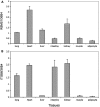Genetic variants at 2q24 are associated with susceptibility to type 2 diabetes
- PMID: 20418489
- PMCID: PMC2883345
- DOI: 10.1093/hmg/ddq156
Genetic variants at 2q24 are associated with susceptibility to type 2 diabetes
Abstract
To identify type 2 diabetes (T2D) susceptibility loci, we conducted genome-wide association (GWA) scans in nested case-control samples from two prospective cohort studies, including 2591 patients and 3052 controls of European ancestry. Validation was performed in 11 independent GWA studies of 10,870 cases and 73,735 controls. We identified significantly associated variants near RBMS1 and ITGB6 genes at 2q24, best-represented by SNP rs7593730 (combined OR=0.90, 95% CI=0.86-0.93; P=3.7x10(-8)). The frequency of the risk-lowering allele T is 0.23. Variants in this region were nominally related to lower fasting glucose and HOMA-IR in the MAGIC consortium (P<0.05). These data suggest that the 2q24 locus may influence the T2D risk by affecting glucose metabolism and insulin resistance.
Figures




References
-
- Stumvoll M., Goldstein B.J., van Haeften T.W. Type 2 diabetes: principles of pathogenesis and therapy. Lancet. 2005;365:1333–1346. doi:10.1016/S0140-6736(05)61032-X. - DOI - PubMed
-
- Qi L., Hu F.B., Hu G. Genes, environment, and interactions in prevention of type 2 diabetes: a focus on physical activity and lifestyle changes. Curr. Mol. Med. 2008;8:519–532. doi:10.2174/156652408785747915. - DOI - PubMed
-
- McCarthy M.I., Zeggini E. Genome-wide association studies in type 2 diabetes. Curr. Diab. Rep. 2009;9:164–171. doi:10.1007/s11892-009-0027-4. - DOI - PMC - PubMed
-
- McCarthy M.I. Progress in defining the molecular basis of type 2 diabetes mellitus through susceptibility-gene identification. Hum. Mol. Genet. 2004;13(Spec. 1):R33–R41. - PubMed
-
- Zeggini E., Scott L.J., Saxena R., Voight B.F., Marchini J.L., Hu T., de Bakker P.I., Abecasis G.R., Almgren P., Andersen G., et al. Meta-analysis of genome-wide association data and large-scale replication identifies additional susceptibility loci for type 2 diabetes. Nat. Genet. 2008;40:638–645. doi:10.1038/ng.120. - DOI - PMC - PubMed
Publication types
MeSH terms
Substances
Grants and funding
- U01HG004738/HG/NHGRI NIH HHS/United States
- N01-HC-55016/HC/NHLBI NIH HHS/United States
- N01- HC-55022/HC/NHLBI NIH HHS/United States
- N01-HC-55019/HC/NHLBI NIH HHS/United States
- N01-HC-55015/HC/NHLBI NIH HHS/United States
- T32 ES016645/ES/NIEHS NIH HHS/United States
- R90DK071507/DK/NIDDK NIH HHS/United States
- N01-HC- 55018/HC/NHLBI NIH HHS/United States
- RFAHG006033/PHS HHS/United States
- R01 HL71981/HL/NHLBI NIH HHS/United States
- U01HG004446/HG/NHGRI NIH HHS/United States
- UL1RR025005/RR/NCRR NIH HHS/United States
- CA54281/CA/NCI NIH HHS/United States
- N01-HC-25195/HC/NHLBI NIH HHS/United States
- CA1367 92/CA/NCI NIH HHS/United States
- U01HG004726/HG/NHGRI NIH HHS/United States
- U01HG004438/HG/NHGRI NIH HHS/United States
- U10AA008401/AA/NIAAA NIH HHS/United States
- P01CA087969/CA/NCI NIH HHS/United States
- HL043851/HL/NHLBI NIH HHS/United States
- K01- DK067207/DK/NIDDK NIH HHS/United States
- P01CA 089392/CA/NCI NIH HHS/United States
- R01HL59367/HL/NHLBI NIH HHS/United States
- P01CA055075/CA/NCI NIH HHS/United States
- R01DK078616/DK/NIDDK NIH HHS/United States
- HL69757/HL/NHLBI NIH HHS/United States
- U01HG004415/HG/NHGRI NIH HHS/United States
- U01HG004735/HG/NHGRI NIH HHS/United States
- T90 DK070078/DK/NIDDK NIH HHS/United States
- U01DE018 993/DE/NIDCR NIH HHS/United States
- U01HG0047 29/HG/NHGRI NIH HHS/United States
- K24 DK080140/DK/NIDDK NIH HHS/United States
- HHSN268200625226C/PHS HHS/United States
- U01HG004728/HG/NHGRI NIH HHS/United States
- U01HG004399/HG/NHGRI NIH HHS/United States
- N01-HC-55021/HC/NHLBI NIH HHS/United States
- U01HG004402/HG/NHGRI NIH HHS/United States
- U01HG004422/HG/NHGRI NIH HHS/United States
- CA63464/CA/NCI NIH HHS/United States
- K23 DK65978/DK/NIDDK NIH HHS/United States
- R01DA013423/DA/NIDA NIH HHS/United States
- CA047988/CA/NCI NIH HHS/United States
- U01HG04424/HG/NHGRI NIH HHS/United States
- R01HL087641/HL/NHLBI NIH HHS/United States
- U01HG004423/HG/NHGRI NIH HHS/United States
- N01-HC-55020/HC/NHLBI NIH HHS/United States
- U01HG0 04436/HG/NHGRI NIH HHS/United States
- R01DK058845/DK/NIDDK NIH HHS/United States
- HHSN268200782096C/HG/NHGRI NIH HHS/United States
- U01DE018903/DE/NIDCR NIH HHS/United States
- R01 HL071981/HL/NHLBI NIH HHS/United States
- N02-HL-6-427/HL/NHLBI NIH HHS/United States
- DK46200/DK/NIDDK NIH HHS/United States
- Z01CP010200/CP/NCI NIH HHS/United States
- R01DK075046/DK/NIDDK NIH HHS/United States
- R01HL086694/HL/NHLBI NIH HHS/United States
LinkOut - more resources
Full Text Sources
Medical

